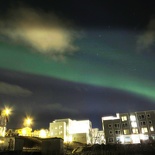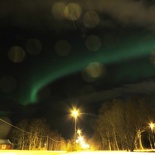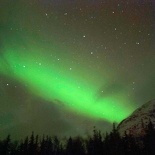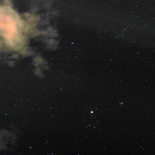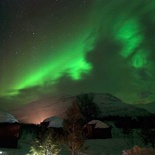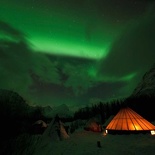Northern Lights is a common name for the Aurora Borealis (Polar Aurorae) in the Northern Hemisphere. These beautiful lights illuminate the northern horizon as a greenish glow or sometimes a faint red, formed from cyclic solar activity, peaking roughly every 11 years with the next peak period starting this December winter and throughout 2013. Aurora activity is usually best on cold days, which makes this winter the best time to catch it. Majority of the aurora activities are also predicted to be situated directly over Norway, specifically over the city of Tromsø where I was located to hunt the lights. Tromsø is also an ideal location in winter with only one hour of daylight every winter. Thus the hunt out for the lights can start as early as 5pm with a 2 hour drive into the mountains away from the city lights and clouds.
Science behind the Northern Lights
On a little bit of theory, the northern lights are largely caused by solar storms from the sun, derived from the solar wind, particularly spots of strong magnetic fields being ejected from the surface of the sun usually on 10 to 11 year cycles or as sun spots. This ejection of magnetic fields creates a “solar wind” which travels outward from the center of our solar system (where the sun is) to all the planets orbiting the sun itself. It takes on average 18 hours for this fast moving magnetic field to blow past mercury, venus and eventually earth.
The collision of the solar wind is largely shielded on earth given the protection of the earth’s own magnetic field. There are 2 phases in which the earth channels these magnetic energy from the solar wind- one on the initial forward/collision phase of the solar wind with the earth which is captured and directed to the poles of the earth in the day, which is often not very visible to the eye) and the second phase as the solar wind moves past earth, with the earth’s magnetic field trapping in some of the remainder magnetic energy and channeling them back to the poles at night, thus creating the night time Aurora Borealis.
This concentration of the magnetic fields at the poles often have large potential difference of at least 40,000 volts, rising up to more than 200,000 volts during intense magnetic storms. These energetic charged particles reacts with the air modules in the high altitude atmosphere (thermosphere), with different gas reactions emitting photons of different wavelengths and thus different colours of the northern light. Oxygen emissions are the most prevalent in the lower atmosphere, which give the lights a predominantly green colour. High altitude oxygen gives a brownish-red, depending on the amount of energy absorbed. Nitrogen produces the very rare emissions blue or red colours. The lights of the Aurora generally extend from 80km from ground level to as high as 640km. In the early days, the Northern lights were perceived to be the “Dance of the Spirits”. In Europe, in the Middle Ages, the auroras were commonly believed a sign from God.
When to see it
The lights are can be seen as early as 5pm in the late afternoons to as late as 4am at night, though the most active recorded periods are usually 8-10pm from my personal experiences when out hunting for the lights, as reaffirmed by the local knowledge. The lights can linger in the sky as long as 2 hours to as short as 5 – 30 seconds- a challenge at several times where the lights will simply just disappear the moment I get my camera setup to capture it. The lights can appear in small wavy patterns or localized patches in the sky to long wide-streaks which can span your whole frontal view over 180 of viewing angle. If you are lucky you might be able to catch a few shooting stars streaks in your long exposure shot.
It takes many factors for the lights to be visible- temperature, ionization, cloud cover and luck. As the lights form on the upper atmosphere, sometimes the lights will form but are obscured by dense cloud cover. The northern lights will come and go at an instant, sometimes forming and disappearing in the matter of minutes, while some will linger on for 30 mins at a go, so it is good to have your camera and tripod in hand. Some small formations are not obvious to the naked eye and can be mistaken from cloud cover, as such it will be recommended to use your camera slow shutter to distinguish between clouds (white streaks) to the northern lights (predominantly green from nitrogen).
How to capture the Northern lights on Camera
To capture the northern lights effectively, you will firstly need a very keen eye as well as a camera with adjustable aperture, shutter speeds allowing small aperture sizes and long exposure times of at least 15 seconds. For very faint Northern lights, sometimes you need to go as long as 30 seconds, but at the risk of a smeared image as the lights are often not stationary in the night sky. Having said that, you need to strike an optimal balance between formation sharpness and blurriness from the always-moving/changing lights. Longer exposures will give you larger streaks, with brighter and more distinct green hues, but appear more washed out due to their movement.
A tripod is of course a no-brainer and a must, especially shooting out in the fields. Sometimes the lights are so faint that it cannot be seen by the naked eye, thus cameras are essential not only to capture the lights, but the identify their span in the sky and differentiating the lights from an occasional cloud.
I had the opportunity to chat with few locals in the area on their opinions of the northern lights, thinking that it could be something the locals here take for granted having to see the lights almost every other night here in Norway. It is not when I come to learn from them that the Northern light is always something they are always look forward to in fascination every winter. Many Northern lights hunters here often camp out in the open dark clearings away from the city out the night with their cameras to catch the best lights in action.
This winter in particular is one not to be missed too as the skies are due for their strongest aurora cycle for one of the most active Northern light over the region in 11 years. The activity got so strong on some nights that you are even able to spot them from the city itself.
Definitely an experience of a lifetime.

